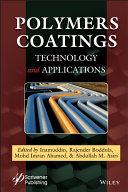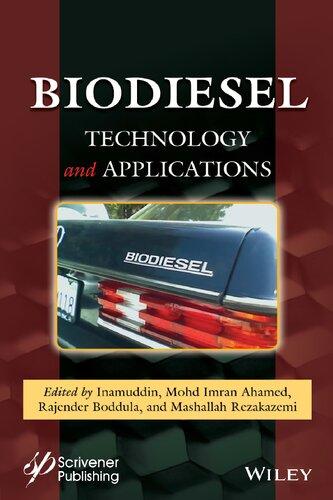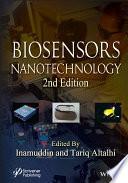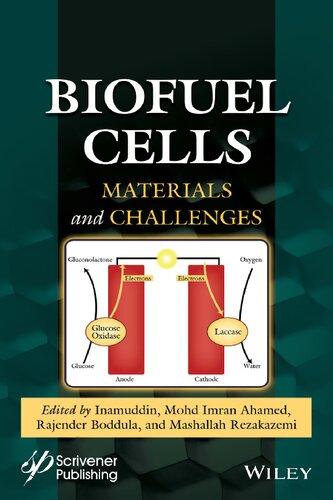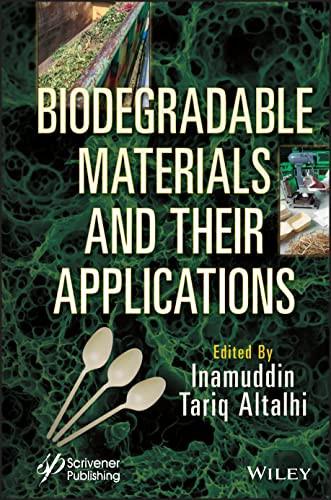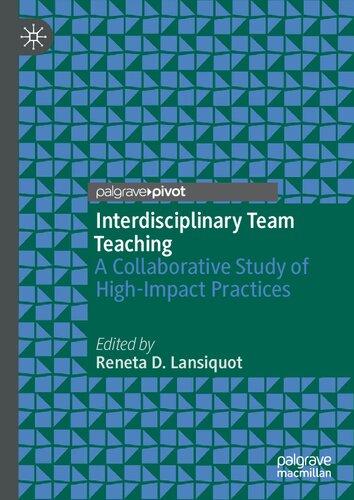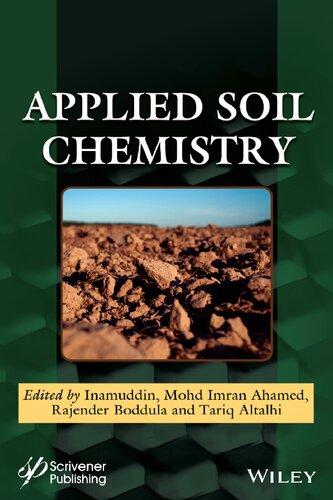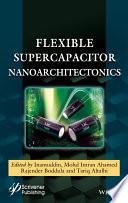Biofertilizers Study and Impact
Edited by Inamuddin, Mohd Imran Ahamed, Rajender Boddula, and Mashallah Rezakazemi
This edition first published 2021 by John Wiley & Sons, Inc., 111 River Street, Hoboken, NJ 07030, USA and Scrivener Publishing LLC, 100 Cummings Center, Suite 541J, Beverly, MA 01915, USA © 2021 Scrivener Publishing LLC
For more information about Scrivener publications please visit www.scrivenerpublishing.com.
All rights reserved. No part of this publication may be reproduced, stored in a retrieval system, or transmitted, in any form or by any means, electronic, mechanical, photocopying, recording, or otherwise, except as permitted by law. Advice on how to obtain permission to reuse material from this title is available at http://www.wiley.com/go/permissions.
Wiley Global Headquarters
111 River Street, Hoboken, NJ 07030, USA
For details of our global editorial offices, customer services, and more information about Wiley products visit us at www.wiley.com.
Limit of Liability/Disclaimer of Warranty
While the publisher and authors have used their best efforts in preparing this work, they make no representations or warranties with respect to the accuracy or completeness of the contents of this work and specifically disclaim all warranties, including without limitation any implied warranties of merchantability or fitness for a particular purpose. No warranty may be created or extended by sales representatives, written sales materials, or promotional statements for this work. The fact that an organization, website, or product is referred to in this work as a citation and/or potential source of further information does not mean that the publisher and authors endorse the information or services the organization, website, or product may provide or recommendations it may make. This work is sold with the understanding that the publisher is not engaged in rendering professional services. The advice and strategies contained herein may not be suitable for your situation. You should consult with a specialist where appropriate. Neither the publisher nor authors shall be liable for any loss of profit or any other commercial damages, including but not limited to special, incidental, consequential, or other damages. Further, readers should be aware that websites listed in this work may have changed or disappeared between when this work was written and when it is read.
Library of Congress Cataloging-in-Publication Data
ISBN 9781119724674
Cover image: Wikimedia Commons
Cover design by Russell Richardson
Set in size of 11pt and Minion Pro by Manila Typesetting Company, Makati, Philippines
Printed in the USA
10 9 8 7 6 5 4 3 2 1
4.2.2
4.2.2.1
4.2.2.2
4.3.2.1
4.3.2.2
5.6
A. Mbotho, D. Selikane, J.S. Sefadi and M.J.
6.1
6.2
6.2.1
6.2.2
7.3.4.1
7.4
7.6
7.7
8 Scoping the Use of Transgenic
Vasavi Rama Karri and Nirmala Nalluri
8.3.1
8.3.2
8.3.3
8.3.4
8.3.5
8.3.6
8.4.3
8.5 Biofertilizers
8.5.1
8.5.2
8.6
8.6.1
8.6.2
8.6.3
8.6.4
8.7
8.6.5 Generation of Genetically Modified Transgenic Azospirillum Strains With Enhanced Levels of Phytoharmone Secretion
8.6.6 Development of Rhizobium Strains With Increased Competitiveness by Genetic Modification
8.6.7 Effect of GM Rhizobial strains on Arbuscular Mycorrhizal (AM) Fungi
8.6.8 Release of Genetically Manipulated Rhizobium for Field
Osikemekha Anthony Anani, Charles Oluwaseun Adetunji, Osayomwanbo Osarenotor and Inamuddin
9.1
9.2 Application of Biofertilizer as Bioaugmentation Agent for Bioremediation of Heavily Polluted Soil
9.3 Advantages of Biofertilizer in Comparison With Synthetic Fertilizer
9.4 Specific Examples of a Biofertilizer for Crop Improvement in Agricultural
9.5
9.6 Combinatory Effect of Biofertilizer With Other Substance and Their Effect on Crops
Rimjim Gogoi, Sukanya Baruah and Jiban Saikia
11
V. Shanthi
Jasti Tejaswi, Kaligotla Venkata Subrahmanya Anirudh, Lalitha Rishika Majeti, Viswanatha Chaitanya Kolluru and Rajesh K. Srivastava
15.4.3
15.5
15.5.1
spp. (AZT) and Azospirillum spp. (AZP) on Eucalyptus
15.5.2 Bradyrhizobium Strains and Streptomyces griseoflavus on Some Leguminous, Cereal, and Vegetable Crops
15.5.3
15.5.4 Arbuscular Mycorrhizal and Phosphate Solubilizing Fungi on
15.6 Screening of Microbes for Biofertilizer
15.6.1
Andrew N. Amenaghawon, Chinedu L. Anyalewechi and Heri Septya Kusuma
16.4
16.6
16.5.1
16.5.2
16.5.6
16.6.1
16.6.2
16.6.3
16.7
18
Industry Profiles in Market
Kashish Gupta
18.1
18.6
18.7
18.8
18.9
19.1
19.2
19.3
20
Tanushree Chakraborty and Nasim Akhtar
20.1
20.2.2
20.3 Advances in Biofertilizer 580
20.4 Preparation of Biofertilizer 581
20.5 The Carrier Materials 581
20.6 Production System of Biofertilizer 582
20.7 Mechanism of Growth-Promoting Activity of Biofertilizers 583
20.8 Advantages and Limitations 584
20.9 Future Aspects 584
20.10
21 Biofertilizers: Past, Present, and Future 591
Mukta Sharma and Manoj Sharma
21.1 Introduction 592
21.2 Biofertilizer: A Brief History 593
21.3 Biofertilizer Classification 594
21.4 Different Paradigms of Biofertilizers 596
21.4.1 Impregnation of Fertilizers and Fertilizer Use Efficiency 596
21.4.2 Inoculants of Mixtures of Microorganisms 597
21.4.3 Different Formulations of Inoculants 597
21.4.4 Inoculant Carrier 598
21.4.5 Biofertilizer Carriers and Liquid Formulations 599
21.4.6 Controlled Release Techniques: Encapsulation, Lyophilization, and Drying 600
21.5 Biofertilizers: Current Status 601
21.6 Biofertilizers: Future Paradigm 601
21.7 Conclusion 602 References 603 22 Algal Biofertilizer 607
Muhammad Mudassir Iqbal, Gulzar Muhammad, Muhammad Shahbaz Aslam, Muhammad Ajaz Hussain, Zahid Shafiq and Haseeba Razzaq
22.1 Introduction 608
22.2 Algae and Algal Biofertilizers 609
22.2.1 Algae is a Polyphyletic Functional Group 609
22.2.2 Multifaceted Role of Algal Biofertilizer in Sustainable Cultivation 610
22.2.3 Biostimulants From Algae 612
22.3 Techniques of Application of Algal Biofertilizer 613
22.3.1 Algal Extracts as Biofertilizer
22.3.2 Addition of Algal Strains and Algal Biofertilizer to Soil
22.4 Cultivation of Algae and Production of Algal Biofertilizer
Conclusion
Preface
Great attention has been paid to reduce the use of conventional chemical fertilizers harming living beings through food chain supplements from the soil environment. Therefore, it is necessary to develop alternative sustainable fertilizers to enhance soil sustainability and agriculture productivity. Biofertilizers are the substance that contains microorganisms (bacteria, algae, and fungi) living or latent cells that can enrich the soil quality with nitrogen, phosphorous, potassium, organic matter, etc. They area costeffective, biodegradable, and renewable source of plant nutrients/ supplements to improve the soil-health properties. Biofertilizers emerge as an attractive alternative to chemical fertilizers and as a promising costeffective technology for eco-friendly agriculture and a sustainable environment that holds microorganisms which enhance the soil nutrients’ solubility leading a raise in its fertility and stimulate crop growth and healthy food safety.
This book provides in-depth knowledge about history and fundamentals to advances biofertilizers, including latest reviews, challenges, and future perspectives. It covers fabrication approaches and various types of biofertilizers and their applications in agriculture, environment, forestry, and industrial sectors. Also, organic farming, quality control, quality assurance, food safety, and case studies of biofertilizers are briefly discussed. Biofertilizers’ physical properties, affecting factors, impact, and industry profiles in the market are well addressed. This book is an essential guide for farmers, agrochemists, environmental engineers, scientists, students, and faculty who would like to understand the science behind the sustainable fertilizers, soil chemistry, and agroecology, etc.
Chapter 1 focuses on the various action mechanisms observed in microorganisms, those that drive effective biofertilizer functions for forestryrelated utilization. Besides, the chapter discusses the factors influencing the success of forestry-related biofertilizer applications as well as the current use and prospects of biofertilizers in the forestry sector.
Chapter 2 highlights the impact of applying biofertilizers on horticultural crops including the possible mechanisms, leading to improved crop growth and stress tolerance. Possible challenges of biofertilizer application and recommended solutions to these problems are also discussed to ensure the efficient use of biofertilizers in the horticulture industry.
Chapter 3 discusses various microorganisms which as act as biofertilizers and also the nitrogen-fixing bacteria including different symbiotic and asymbiotic nitrogen-fixing microbes and other substitutes for easy making of biofertilizers. The major focus is given to innovative methods, for example, growing of microorganisms, accumulation of microorganisms, and conveniences for distribution, applying, and framing of microorganisms for moving from greenhouse and laboratory to field test.
Chapter 4 highlights the usefulness of organic manure in biofarming. Various types of agrochemicals have spoiled our life, environment, and ecosystem. This chapter provides a detailed discussion about how organic manure can save the life of our earth and how it is better than agrochemicals.
Chapter 5 reviews the scientific literature on environmental phosphorus pollution and mechanisms of phosphate solubilization through intact bacteria and fungi or their enzymes. Moreover, inoculation methodologies, factors affecting the inoculum efficiency, and applications of single or multiple species as promising biofertilizer components for sustainable and ecological farming practices are summarized.
Chapter 6 reviews plant-microbe associations occurring both exo- and endophytically on different plant species. The beneficial and pathogenic outcomes of these interactions are discussed, highlighting the microorganisms and the plants involved. Furthermore, the importance of research of these interrelationships is considered concerning use in agriculture for the development of agricultural agents.
Chapter 7 discusses the different formulation technologies of biofertilizers used to mitigate the harmful effects of chemical fertilizers. The complete formulation process is discussed, highlighting the significance of each step, i.e., types of selected microbes, choice of suitable carrier, and addition of sticking materials while unifying the biofertilizer formulation.
Chapter 8 describes the scope of exploiting efficient transgenic microorganisms produced by genetic engineering strategy as potential biofertilizers to enhance the yield of crops through the sustainable farming approach. Furthermore, environment-friendly benefits of utilizing various types of microorganisms alternative to chemical fertilizers in improving soil fertility of agricultural lands are also emphasized.
Chapter 9 intends to provide detailed information on the application of biofertilizer as a sustainable biotechnological tool that could lead to an increase in agricultural production. Detailed information is provided on the modes of action of these biofertilizers while specific examples of cases where biofertilizer has been utilized for improving an increase in agricultural production are also discussed.
Chapter 10 discusses the various characteristic properties, utility, and challenges of free-living nitrogen-fixing bacteria of the genus Azospirillum as a commercial inoculant, aimed to enhance the nitrogen availability in the soil for sustainable agriculture. Mechanistic routes aiding in nitrogen fixation by the bacteria are comprehensively elaborated.
Chapter 11 discusses the beneficial role of actinomycetes in the field of sustainable agriculture. Its unique ability to mitigate soil ecosystem and to promote plant growth by producing important agro-active substances is highlighted. Also, the role of actinomycetes to serve as a potential and efficient source of biofertilizer is discussed.
Chapter 12 discusses the influence of growth conditions and other parameters including morphological patterns of cyanobacterial species, found in biofertilizer quality and nutrients richness.
Chapter 13 provides the positive influences of biofertilizers’ application on agricultural sector via improving the productivity and yields of the crop. Further, it discusses the role of biofertilizers’ production and promotion, with a viable option to chemical fertilizers that have minimized the productivity of the crop with negative impacts on soil, water bodies, or environment components.
Chapter 14 provides detail informationabout the necessity of quality control of biofertilizers. Quality supervision is crucial and should be achieved constantly to manage the microbial products in support of the clients. The rules applied for calculating the quality are restricted to the concentration and viability of the microbes.
Chapter 15 focuses on the significance of biofertilizers with their microbial composition having an edge over chemical fertilizers. The emphasis is on recent advances in preparation, mechanism, growth promotion, carrier materials, and production system of biofertilizers. The chapter also discusses the prospects of biofertilizers along with its advantages and limitations.
Chapter 16 provides an in-depth understanding of biofertilizers and the various approaches available for their preparation. The chapter ends with some prospects and recommendations needed for further improvements in the development, preparation, and application of biofertilizers to achieve green, cleaner, and sustainable food production.
Chapter 17 discusses the use of biofertilizers based on waste recycling as a potential substitute for chemical fertilizers. Initially, an overview of biofertilizers is presented. Furthermore, the main sources of organic waste are discussed, as well as the appropriate treatment processes. Finally, emerging technologies and the main applications of biofertilizers are presented.
Chapter 18 clearly describes the know-how of biofertilizer technology, its segments, and a brief description of the types of biofertilizer available in the market. The highlight of the chapter is the recent trend in biofertilizer technology: liquid biofertilizer, its merits over conventional fertilizers, and future potentials.
Chapter 19 discusses the current situation on the application of biofertilizer in Africa and their mechanism of action. Different types of biofertilizer that have been introduced are also highlighted. Moreover, specific examples are cited where biofertilizer has led to an increase in agricultural production.
Chapter 20 focuses on various types of biofertilizers, their properties, significance, preparation, production, uses, and outcome. It also focuses on experimental designing on screening and selection of microbes and their optimization as biofertilizers. The chapter also deals with the success of biofertilizers, their limitations, and new approaches to overcome constraints.
Chapter 21 discusses the use of microorganisms in the form of biological fertilizers. It also discusses the characteristics and features of different formulations in which the biofertilizers are used extensively. The chapter highlights the development and recent advances in biological fertilizer and its performance.
Chapter 22 covers the biodiversity of algae and biochemical constituents of algal biofertilizers with the effects on plant growth and yield. The state-of-the-art techniques for the mass cultivation of algae are also part of the discussion. This chapter also focuses on novel strategies for the mass production of algal biofertilizers.
Biofertilizer Utilization in Forestry
Wendy Ying Ying Liu* and Ranjetta Poobathy School of Biological Sciences, Quest International University, Perak, Malaysia
Abstract
The forest biomes provide crucial ecosystem services which include acting as carbon sinks, providing habitats for biodiversity, preventing soil erosion, mitigating climate change, and producing important resources such as timber, fuel, and bioproducts. However, due to various human activities, the productivity of forests has greatly reduced over time. In order to manage nutrient deficiencies and phytopathogens, chemical products are utilized in forest nurseries, plantation forests, and natural stands. However, this often leads to nutrient losses via leaching, gaseous losses, and other detrimental effects. Exploitation of biofertilizers in the bid to reduce reliance on chemicals could promote the growth and development of tree species and ultimately increase forest productivity in a more sustainable manner. Most biofertilizer utilizations are focused in the agriculture and horticulture sectors with less emphasis in forestry, with the exception of mycorrhizae. It is imperative to recognize the various mechanisms of action of biofertilizers (e.g., facilitation of nutrient uptake, phytohormone modulation, and phytoprotection) to fully exploit the potential of biofertilizer in promoting the ecosystem services of forest biomes. Hence, this chapter explores the mechanisms of action of effective microorganisms in biofertilizers, factors influencing the effectiveness of biofertilizer application, and applications of biofertilizers in the forestry sector.
Keywords: Biofertilizer, forestry, plant growth promoting microorganisms, biological nitrogen fixation, mycorrhizae, phytohormones, biocontrol, sustainability
*Corresponding author: wendy.liu@qiup.edu.my
Inamuddin, Mohd Imran Ahamed, Rajender Boddula, and Mashallah Rezakazemi (eds.) Biofertilizers: Study and Impact, (1–38) © 2021 Scrivener Publishing LLC
1.1 Introduction
The forest biomes are globally important as they cover 30% of Earth’s terrestrial surface with more than three trillion trees at an estimated size of four billion hectares [1–3]. The forest ecosystem services include, but are not limited to, acting as carbon sinks, providing biodiversity, protecting soil quality, and producing a wide array of resources such as wood, timber, biomass, and coal [4, 5]. The forest ecosystems are widely distributed worldwide, in boreal, temperate, and tropical regions [6]. For some forest ecosystems, their distributions are highly correlated to land use and soil characteristics, whereby nutrient-poor soils are allocated for forests while high fertility soils are utilized for agriculture crops and grasslands [6]. The productivity of forests has been on a decline due to accelerated growth of human and livestock populations, forest fires and undiscerning exploitation of forest products [7]. These human activities have led to continuous soil erosion causing the forest soils to experience deficiencies of essential nutrients [8].
Chemical fertilizer usage in forestry, from forest nurseries to plantations and natural stands, ranges from zero to very minimal in comparison to its usage in the agriculture sector [9]. In the field, fertilizers are typically applied only once, or at maximum, a few times over a rotation that takes 25 to 30 years [10–12]. The application of chemical fertilizer, when required, allows management of nutrient deficiencies in marginal soils, increased productivity of planted forests and/or maintenance of sustainable soil nutrients after successive rotations [10, 11]. However, the use of chemical fertilizers has its drawbacks. Firstly, excessive applications in the field could lead to nutrient losses via leaching, gaseous losses, and reduced beneficial forest microbiomes [13]. Also, it is arduous to fertilize forest soils due to the remoteness, low accessibility, and low fertility of many forests [6]. Hence, it is more viable to exploit the potential of biofertilizers to reduce the reliance on chemical fertilizers to promote the growth and development of tree species and ultimately promote sustainable forest productivity.
Biofertilizers are products containing beneficial microorganisms, mainly bacteria and fungi, which can inhabit the rhizosphere and/or plant interiors and subsequently promote plant growth via application onto seeds, plants, and/or soil [14, 15]. Such microorganisms, also known as plant growth promoting microorganisms (PGPMs), can directly increase plant growth by facilitating nutrient acquisition in plants and modulating phytohormones while indirectly promote plant growth by decreasing inhibitory effects of phytopathogens while making the rhizosphere more favorable for
plants and other beneficial microorganisms [16–18]. The utilization of biofertilizer in agriculture and horticulture is more extensive and widespread while the utilization of biofertilizers in forestry is still under investigation or restricted to forest nurseries, with most studies focusing only on mycorrhizae [19, 20]. It is imperative to explore other beneficial microorganisms and their mechanisms of actions to fully utilize the potential of biofertilizer in promoting growth of tree species, be it in forest nurseries, plantations, and/or natural stands, in order to fully harness the ecosystem services of forest biomes.
1.2 Mechanisms of Actions of Biofertilizers
Biofertilizers could improve plant health and growth, soil nutrient, and fertility status in forest biomes [21]. Nonetheless, the efficacy of the biofertilizers could be greatly affected by various external factors including soil characteristics, tree species, and native microbiome composition [22]. Hence, it is crucial to understand the mechanisms of actions of PGPMs [inclusive of the commonly used term, plant growth promoting rhizobacteria (PGPR)] utilized in biofertilizer so as to employ them under appropriate circumstances. In reality, many PGPMs are likely to employ more than a single mechanism, either simultaneously or at different times under different conditions [14, 17]. The mechanisms of action of PGPMs comprise of aiding nutrient uptake [e.g., nitrogen (N), phosphorus (P), potassium (K), iron (Fe), zinc (Zn), and sulfur (S), modulation of phytohormones (e.g., abscisic acid, cytokinin, ethylene, indole acetic acid (IAA), and gibberellin (GA)] and biocontrol ability to confer phytoprotection [17, 23–25].
1.2.1 Facilitation of N Acquisition
Nitrogen is vital for plant growth and development as it is a major component of nucleic acids, membrane lipid, amino acids, proteins, chlorophylls, and enzymes [18, 26]. However, N is a key limiting nutrient in forest biomes, especially in forest ecosystems that are developed on marginal soils [27–29]. Despite N abundance in the atmosphere as N2, most plants are incapable of utilizing it and are highly dependent on soil N bioavailability, in organic and inorganic N forms, to sustain their growth. However, N2 can be converted into inorganic forms, such as ammonium and nitrate, by the aid of N2-fixing microorganisms via a highly energy intensive biological N2 fixation (BNF) process catalyzed by nitrogenase [23, 30]. Nitrogen-fixing
microorganisms in forest biomes can be categorized into two categories: (i) symbiotic N2 fixers (e.g., rhizobia in association with leguminous plants and Frankia spp. in association with actinorhizal plants) and (ii) nonsymbiotic N2 fixers (in free-living, associative or endophytic forms) [17, 23]. Nevertheless, symbiotic N2 fixation contributes to majority of the amount of fixed N required by plants in comparison to non-symbiotic N2 fixation [17]. Most literature have referred to symbiotic N2 fixation as symbioses with the development of root nodules while others have also included associative N2 fixation as symbiotic as it fits the definition of symbiosis which is beneficial association between two different organisms [31]. Nonetheless, the former definition will be used in this review.
1.2.1.1 Mutualistic N2 Fixation
Studies have shown that the legume-rhizobia interaction is a main contributor to the amount of fixed N2 in many forest biomes [32]. Many, albeit not all, tree legume species are able to fix atmospheric N2 in association with rhizobia, a group of gram-negative bacteria that are capable of forming N2 nodules on mainly leguminous roots, under N-deficient conditions [33]. Rhizobia can penetrate leguminous root tissues either via hair infection, crack entry or epidermal entry [34]. Most legumes employ the root hair infection strategy where flavonoids secreted by the plants will signal for rhizobia to secrete signal molecules (Nod factors) that binds to root hair cell receptors and then results in the curling of root hair, bacterial entry into the cells of the root hair, division of cortical cells, followed by the formation and ramification of an infection thread in developing nodule primordia [35, 36]. Subsequently, the bacteria will differentiate morphologically to form bacteroids and are eventually removed from the infection thread to form symbiosomes via the synthesis of nitrogenase [35–37]. Ammonium produced in the nodules will be transported to plant cells where it will be assimilated into amino acids for the plant’s use via the glutamine synthetase (GS)/glutamate synthase (GOGAT) pathway [38]. While rhizobia provide N source for plant growth, the legumes provide protection and photosynthates for the rhizobia as a carbon source [39].
Another common N2-fixation symbiosis in forest biomes is the interaction between actinorhizal plants and the actinomycete Frankia via nodule formation [40, 41]. Many actinorhizal trees and shrubs can form mutualisms with mycorrhizae and tripartite symbiosis (actinorhizal plant-Frankiamycorrhiza), thus providing them an edge to grow in soils with poor nutrient availability [42, 43]. The strategy employed by Frankia in infecting their host plants will depend on the host and Frankia species involved. Nonetheless,
they are similar to those employed by rhizobia, which are hair infection, crack entry, or epidermal entry. For actinorhizal plants that belong in the order Fagales, their intracellular infection progress through via root hairs while for those in the Rosales, the intracellular entry of Frankia is through the roots [43]. Nodules produced by actinorhizal plants have indeterminate growth and are able to fix a substantial amount of N2 that is equivalent to those produced by legumes [43, 44].
1.2.1.2 Non-Symbiotic N2 Fixation
Many free-living heterotrophic diazotrophs in the rhizosphere, such as Azotobacter and Klebsiella, are also capable of fixing atmospheric N2, albeit without direct interaction with any other organisms [45–47]. Hence, these bacteria have to source for their own energy to carry out the highly energy-intensive BNF process. They can usually oxidize organic molecules released through decomposition or the aid of other organisms while some have chemolithotrophic abilities in utilizing inorganic compounds instead in order to obtain their energy sources [48]. It has been reported that the free-living BNF rates are strongly correlated to soil organic matter contents, with higher rates in woody residues and surface organic layers compared to mineral soil [48, 49]. Also, as oxygen inhibits nitrogenase activities, these bacteria will have to be able to act as anaerobes or microaerophiles during the N2 fixation [50, 51]. Thus, with these restrictions, free-living N2 fixation, in comparison with symbiotic N2 fixation, will not be able to contribute greatly to BNF in most of the ecosystems [48, 49]. However, it was also reported that free-living N2 fixers fix substantial amounts of N in rain forests [52, 53]. In addition, studies have shown that leguminous trees in mature tropical forests do not fix as much N due to N deposition [54]. Meanwhile, other bacteria, such as Azospirillum and Herbaspirillum, can form endophytic and/or associate mutualisms with various varieties of plants [17, 55]. This manner of N2 fixation is similar to symbiotic N2 fixation without the formation of specialized structures whereby these diazotrophs receive reduced carbon and other nutrients from the plants while they provide fixed nitrogen for the plants to use [56, 57].
1.2.2 Facilitation of P Acquisition
Despite N being generally recognized as the most limiting nutrient in many forest ecosystems, P is also another major limiting nutrient [58, 59]. Phosphorus is vital for plants as a major component of energy source (ATP) to perform various metabolic processes such as signal transduction,
macromolecule synthesis, respiration, and photosynthesis [30, 60]. It has been widely reported that high N deposition that is not matched by equivalent increase in the P inputs could cause nutritional imbalances which eventually reduce forest growth and productivity [61–63]. Demand for P has been shown to increase as growth promotion takes place following the additions of N as plant P concentrations and N:P ratios decrease [64, 65]. Also, there is evidence suggesting that P limitation has detrimentally affected the rate of N2 fixation in tropical forests that mainly consist of non-leguminous tree species [66, 67].
Phosphorus can be found abundantly in most soil (as organic and inorganic forms) but the amount of accessible P for plants to utilize is low, as >90% of soil P are insoluble and precipitated (e.g., phosphotriesters and aluminium phosphate) [30, 68]. Plants are only able to access soluble P sources such as monobasic (H2PO4) and dibasic HPO 4 2 () ions [30, 140]. Although chemical fertilizer provides sufficient soluble inorganic P, most of them are immobilized quickly after its application, thus rendering them unavailable to plants [17]. Hence, a sustainable alternative would be to employ microorganisms to aid in P solubilization and mineralization. These microorganisms can be divided in two major groups, which are phosphate solubilizing microorganisms (PSMs) and mycorrhizal fungi.
1.2.2.1 Phosphate Solubilizing Microorganisms
PSMs have been shown to effectively increase the accessibility of available P to plants via solubilization and mineralization of complex P compounds [69, 70]. There are a few strategies that can be employed by PSMs to solubilize insoluble P forms, of which the secretion of organic acids (OA) with low molecular weight, such as acetic, citric, and gluconic acids, is recognized as a main way P is solubilized [17, 71, 72]. The OA secreted will either chelate the mineral ions or lower the cell’s pH level in order to acidify these microorganisms and their environments, resulting in the P-ion being released from P-mineral via the swap of H+ for Ca2+ instead [73]. The efficacy of the solubilization process is highly reliant on on the type, concentration, and quality of OAs released into the soil, with the quality of OA being more crucial [74]. The ability of the PSMs to secrete various OAs simultaneously may enhance the P solubilization process further [71]. Some studies have also recommended that the transformation of insoluble P to soluble forms of P could take place without the production of OA [75, 76]. This was reported by Altomare et al. [77] whereby Trichoderma harzianum strain T-22 was able to solubilize P, potentially due to chelation and reduction processes, along with providing biocontrol to the plant

